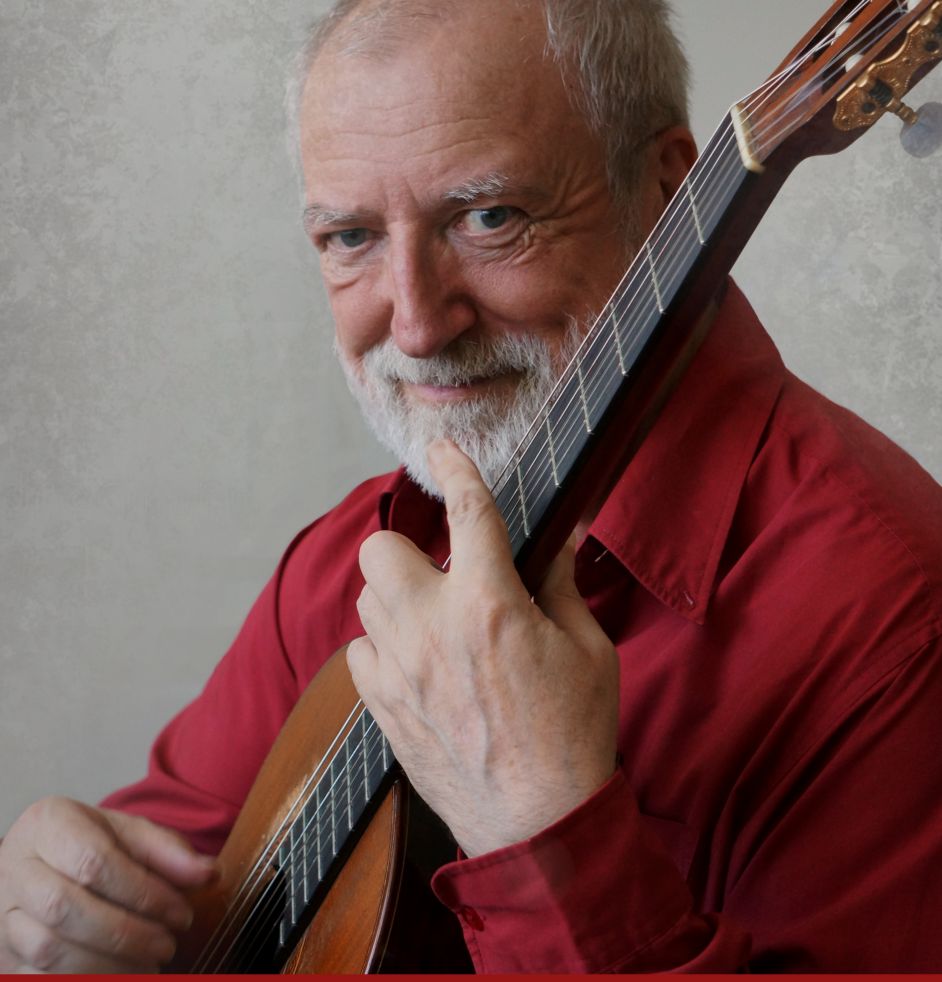


TECHNICAL USE OF ALL FINGERS OF THE RIGHT HAND – NEW TECHNIQUES AND GUITAR EXPRESSIONS
In ancient Greek Areopagus long, ornate introductions were avoided. Here, I will try to introduce my technique and the main factors that have led me to this topic.
1. Humans have five fingers on their hands and I do not see one viable reason why any one of them should be excluded from playing.
2. The natural distance between the thumb and pinkie finger of the right hand enables the use of diametrically different tones for a much more vivid sound.
3. Significant reasons for incorporating the pinkie into play may be justified from a purely historical perspective.
4. Finally, there is the fact that including another finger of the right hand – and even the left hand – offers new possibilities. Contemporary composers provide plenty of substantial justification for this work.
As a composer and musical interpreter myself, I can adequately assess the benefit and phenomenon of incorporating the pinkie to expand our horizons when playing an instrument as beautiful as the guitar inarguably is. Beethoven, himself, once declared that the guitar is a small orchestra in and of itself..
The history of strumming instruments dates way back in history and is, therefore, one of the significant aspects in the development of human culture. As far back as 2500 B.C., the Nefer instrument was already a favorite thanks to the tones and melodic sounds it emitted. The expansion of strumming instruments were then further influenced by the Kelts, an Arian tribe of Welsh nomads and singers of love songs, with other famed troubadours and honorables continuing in the traditon for centuries to come. From the Greek lyre and guitar to the Roman citera, more and more types of strumming instruments came into existence, e.g. the Welsh crwht, later the Welsh harfa and, of course, an entire line of lutes, vihuelas and Baroque guitars. All of these prototypes led to the guitar we know today, although very similar replicas of today’s guitar can be traced back to the 12th century in the Provence region of Southern France or the Principality of Aquitania.
It is apparent that the idea of using all five fingers of the right hand to enhance the technical and expressional variations of strumming instruments is deep-rooted in history. For example, there exist lute tabulatures in which the author specifically requires the use of the pinkie finger to attain the desired sound. It was also of great interest to me that several Baroque compositions require the incorporation of all fingers of the right hand, including the pinkie. As a rule, the pinkie preceded rasguada cascades with the other fingers following in play. Irish banjo players can are another example. They have been using the pinkie finger for ages to create special sounds. It seems trivial – nothing new under the sun – yet, the very topic of why the pinkie has remained unused and ignored for all these years has remained an enigma to me. And this has remained the driving force behind my desire to fully focus all of my efforts in this field.
Current trends in the technical use of the right hand incorporate historical traditions, a practice that is altogether logical.
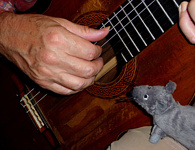
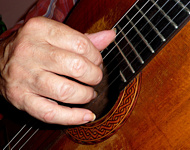 The Segovia technique continually develops the beauty of tones and is based on a solid foundation of the traditional positioning of the right hand - bending the thumb and stroking most chords with the left side of the nail. The main stroke is, therefore, apoyando, or the “rest stroke“. Abel Carlevaro, on the contrary, prefers the tirandu technique, more commonly known today as the “free stroke“. A common example of right hand play is to hold the wrist low while stroking the instrument’s strings at an angle. Prof. Aaron Schearer employs a more natural positioning of the hand while using an angled stroke. John Duarte applies a more flexible positioning of the fingers, recommending the artist to tighten the finger muscles when playing apoyandu, then relaxing the pinkie at a slight angle to enable the nail to lightly slide from one string to the next. John Williams seeks a firm and brilliant tone, while David Russel glorifies his own beautiful technique and tone fullness. Kazuhito Yamashita strives for the orchestral sound and remains one of the few guitarists in the world who makes a point of using the pinkie finger of the right hand. Yamashita has brought attention to the transcripts of Musorgksky Kartinek, where the pinkie tremola is used while the other fingers of the right hand employ a traditional technique. I do not know of anybody else who could manage a similar technique successfully. Charles Postelwate from the USA, with whom I share working contacts, teaches his listeners the five-finger technique with a slightly varied style. He uses the fifth finger more as a training element, which strengthens, while at the same time relaxing the other fingers making them more flexible.
The Segovia technique continually develops the beauty of tones and is based on a solid foundation of the traditional positioning of the right hand - bending the thumb and stroking most chords with the left side of the nail. The main stroke is, therefore, apoyando, or the “rest stroke“. Abel Carlevaro, on the contrary, prefers the tirandu technique, more commonly known today as the “free stroke“. A common example of right hand play is to hold the wrist low while stroking the instrument’s strings at an angle. Prof. Aaron Schearer employs a more natural positioning of the hand while using an angled stroke. John Duarte applies a more flexible positioning of the fingers, recommending the artist to tighten the finger muscles when playing apoyandu, then relaxing the pinkie at a slight angle to enable the nail to lightly slide from one string to the next. John Williams seeks a firm and brilliant tone, while David Russel glorifies his own beautiful technique and tone fullness. Kazuhito Yamashita strives for the orchestral sound and remains one of the few guitarists in the world who makes a point of using the pinkie finger of the right hand. Yamashita has brought attention to the transcripts of Musorgksky Kartinek, where the pinkie tremola is used while the other fingers of the right hand employ a traditional technique. I do not know of anybody else who could manage a similar technique successfully. Charles Postelwate from the USA, with whom I share working contacts, teaches his listeners the five-finger technique with a slightly varied style. He uses the fifth finger more as a training element, which strengthens, while at the same time relaxing the other fingers making them more flexible.
I am glad that most graduates of my courses have been introduced to my method and actually apply them in their play. The entire principle stems from the fact that this five-finger technique can be successfully implemented at an elementary level. On several occasions, beginners have asked me, as well as other collegues, why all fingers of the right hand are not being used. The obvious answer would be that the pinkie is just not commonly used in contemporary styles. It is this very idea that led me to start using the fifth finger just like the rest of the fingers, and from a rather young age.
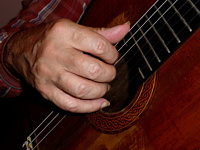 Many of my peers will undoubtedly agree how difficult it is to teach children how to properly place their right hand, and especially to teach the placemet of the fingers on the strings of the guitar. When teaching placement with four fingers on the strings, we find that this placement is indefinite and easily deformed. When all fingers are used (and best placed on one string), we quickly realize how firm this placement is and how difficult it is to change. Even the youngest of students easily understand the principle of the basic placement of the right hand. Then all it takes is a slightly angled adjustment of the pinkie away from the string and in an upward movement and the hand is ready to be used in a conventional, four-finger technique. It is still necessary, however, for the beginner to continually place the pinkie on the strings for ongoing control of the proper placement. That is the main reason for using the pinkie, even though in this phase it is being used rather as support for the standard method of play. It is then up to us whether we remain with this method or further develop our style. The greatest benefit then becomes the overall flexibilty of the fingers of the right hand. From a physiological perspective, the pinkie is, to a substantial degree, dependant on the ring finger since they share a tendon that limits the movement of the pinkie. The ring finger, therefore, often interferes with play unless it is thoroughly exercised. The more we exercise, the more flexible the ring finger, and the other fingers, become.
Many of my peers will undoubtedly agree how difficult it is to teach children how to properly place their right hand, and especially to teach the placemet of the fingers on the strings of the guitar. When teaching placement with four fingers on the strings, we find that this placement is indefinite and easily deformed. When all fingers are used (and best placed on one string), we quickly realize how firm this placement is and how difficult it is to change. Even the youngest of students easily understand the principle of the basic placement of the right hand. Then all it takes is a slightly angled adjustment of the pinkie away from the string and in an upward movement and the hand is ready to be used in a conventional, four-finger technique. It is still necessary, however, for the beginner to continually place the pinkie on the strings for ongoing control of the proper placement. That is the main reason for using the pinkie, even though in this phase it is being used rather as support for the standard method of play. It is then up to us whether we remain with this method or further develop our style. The greatest benefit then becomes the overall flexibilty of the fingers of the right hand. From a physiological perspective, the pinkie is, to a substantial degree, dependant on the ring finger since they share a tendon that limits the movement of the pinkie. The ring finger, therefore, often interferes with play unless it is thoroughly exercised. The more we exercise, the more flexible the ring finger, and the other fingers, become.
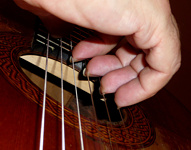 Up until now, I have only described one aspect of play. The vast majority of classic guitarists trained in traditional methods of using the right hand, by rule, ignore one thing. The fact that most strokes are directed toward the palm means an obvious disproportion occurs in countermovement – from the palm outward. Spanish flamenco players unfailingly use countermovement for the rasguada technique. Their technique is, therefore, effortless and virtuosic. It would be wise to learn from them and train the fingers of the left hand by turning the guitar around and training as if one were left-handed. While training with part of the muscle, we inadvertantly ignore the other. In other words, while the palm moves in an outward motion, we are not overcoming an active counterstroke on the strings. This brings us to an important realization. It is equally important to train muscles in the opposite direction in order to fully control them. Most of you will definitely agree that one plays much better and more relaxed when in a familiar environment and, especially, in the evening. With no disturbances, we play and practice effortlessly and brilliantly. Likewise, as though disenchanted, when we play in the morning at a lesson or when warming up, we are suddenly overcome with uncertainty and nervosity. This is because while we are relaxed under ideal circumstances we play naturally and when we are under stress our muscles easily fail us. Fingers do not return to exactly the right position after a stroke because they are not fully under our control. The fingers then become accustomed to irregular movement, especially in keeping the proper distance from strings, resulting in inprecise strokes, or even missing the string entirely. Years of experience have convinced me that it is necessary to train muscles in the opposite direction, and even more so when it comes to the pinkie. It is furthermore necessary to train the left hand, and even the entire body in this way, in order to achieve optimal flexibility. In short, we must incorporate countermovement in our work, from the initial phase of loosening the muscles of the body, all the way to training countermovement of the fingers.
Up until now, I have only described one aspect of play. The vast majority of classic guitarists trained in traditional methods of using the right hand, by rule, ignore one thing. The fact that most strokes are directed toward the palm means an obvious disproportion occurs in countermovement – from the palm outward. Spanish flamenco players unfailingly use countermovement for the rasguada technique. Their technique is, therefore, effortless and virtuosic. It would be wise to learn from them and train the fingers of the left hand by turning the guitar around and training as if one were left-handed. While training with part of the muscle, we inadvertantly ignore the other. In other words, while the palm moves in an outward motion, we are not overcoming an active counterstroke on the strings. This brings us to an important realization. It is equally important to train muscles in the opposite direction in order to fully control them. Most of you will definitely agree that one plays much better and more relaxed when in a familiar environment and, especially, in the evening. With no disturbances, we play and practice effortlessly and brilliantly. Likewise, as though disenchanted, when we play in the morning at a lesson or when warming up, we are suddenly overcome with uncertainty and nervosity. This is because while we are relaxed under ideal circumstances we play naturally and when we are under stress our muscles easily fail us. Fingers do not return to exactly the right position after a stroke because they are not fully under our control. The fingers then become accustomed to irregular movement, especially in keeping the proper distance from strings, resulting in inprecise strokes, or even missing the string entirely. Years of experience have convinced me that it is necessary to train muscles in the opposite direction, and even more so when it comes to the pinkie. It is furthermore necessary to train the left hand, and even the entire body in this way, in order to achieve optimal flexibility. In short, we must incorporate countermovement in our work, from the initial phase of loosening the muscles of the body, all the way to training countermovement of the fingers.
Breathing also plays a rather significant role. Players of strumming instruments often neglect the importance of this practice. As if the fingers didn’t need oxygen! Singers and woodwind musicians alike know how important it is to inhale; as important for everyday life as for the proper arrangement and musical conception of the work itself. I recommend all guitarists to breathe properly, and even to sing, while they are practicing. Lines that we are able to sing when practicing will then sound more familiar when played on the guitar. Let’s now combine controlled breathing with training the pinkie. It is necessary to combine all elements of training to develop our playing skills and improve our overall phsychological state.
In the past, the pinkie’s main task when playing the lute or guitar was to support the rest of the hand. The pinkie rested on the sound board and controlled the stroking precision of the other fingers on the right hand. Even though this practice lent to improving the hand’s overall function, it could not replace the actual activation of the pinkie’s development, which is the issue I am addressing here. Thanks to my extensive teaching experience, I see just how beneficial these exercises are for my students. By activating the pinkie and counter-muscle groups we gain more confidence, control and focus. We don’t fold so easily under pressure and we play more freely even in stressful situations. The dynamics and quality of our tone is an immensly significant factor here. It is necessary to train dynamically, employing a wide range of exercises in both directions when stroking the guitar. All aspects of training should be balanced in a way to ensure these two elements are fully under control.
By actively incorporating the pinkie of the right hand we are revaluating the overall technical and expressional approach to our artisitc performance. An entire new line of ways to express our art, which can be applied to various styles, enable us to expand our guitar repertoire to include entirely new elements.
Thanks to the distance between the fingers of the right hand, we can apply the outer ponticello pinkie simultaneously with the soft, thumb tone sulla tastierra, while the index finger remains in the ordinare position. This method of play is very suggestive, especially when played for a polyphony trio.
If we are able to incorporate the pinkie and make it more independant, we can use the other fingers to create a rich and fast arpeggio, while the pinkie controls the free melody line in soprano.
The pinkie drastically increases the potential of the right hand for various arrangement and rasguada, as well as the speed and resonance of the stroke.
Thanks to its electric sound, the outward stroke may inspire new, distinct elements.
Using the pinkie for tremolo movement opens up an entire range of new possibilities, especially since play is uninterrupted and the thumb is not occupied stroking strong beats. And more options are created for one, two or three other strings, as well. We can reach enormous heights in our play all the way from ppp on up to fff. This method of play requires an extraordinary level of concentration and a long-term, daily work ethic. For composers, this is a welcome proposition of new, dramatic, finger placement on the guitar.
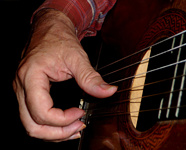
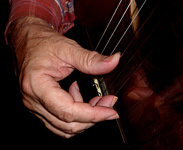 In conclusion, I would just like to stress the practical aspects of this matter in a way that resembles my seminars at several renowned, worldwide universities. I see the five-finger technique as a fundamental element for beginners since using the fifth finger promotes a more stabilized position right from the first lesson. Moreover, we avoid wasting precious time later on with lengthy explanations which only tire the student and teacher. With an active approach to using the pinkie we enrich our traditional technique unimaginably, be they enrichments in expressive or motor skills. And even more so when we factor in conscious training of all muscle groups in the hand by practicing countermovement. This practice helps develop both flexibility and precision – the basic attributes of free, effortless play for both hands. I consider the independance of the pinkie to be quite fundamental (for the right hand as well as for the left), as it is commonly used in traditional guitar techniques, which can be used as a guideline for sychronizing movement of both pinkies. The exercise starts with both pinkies simultaneously striking the same string while we remain consciously aware of the right-hand pinkie gradually taking over with its more flexible and natural movement. I always realize how important it is to develop increased flexibility in the right hand when presenting at my seminars and courses around the world. It is the incorporation of the pinkie in this process that creates all of these new options. Most of my students who apply this method, either personally or for teaching their students, continue to reaffirm just how important a role this technique has played, and what it has meant to them. Even if we only endeavor to use the fifth finger for more effortless play, we will, in any case, develop our overall technical level in all directions. I thoroughly believe the day will come when playing the guitar with all five fingers will be as commonplace as when playing any keyboard instrument.
In conclusion, I would just like to stress the practical aspects of this matter in a way that resembles my seminars at several renowned, worldwide universities. I see the five-finger technique as a fundamental element for beginners since using the fifth finger promotes a more stabilized position right from the first lesson. Moreover, we avoid wasting precious time later on with lengthy explanations which only tire the student and teacher. With an active approach to using the pinkie we enrich our traditional technique unimaginably, be they enrichments in expressive or motor skills. And even more so when we factor in conscious training of all muscle groups in the hand by practicing countermovement. This practice helps develop both flexibility and precision – the basic attributes of free, effortless play for both hands. I consider the independance of the pinkie to be quite fundamental (for the right hand as well as for the left), as it is commonly used in traditional guitar techniques, which can be used as a guideline for sychronizing movement of both pinkies. The exercise starts with both pinkies simultaneously striking the same string while we remain consciously aware of the right-hand pinkie gradually taking over with its more flexible and natural movement. I always realize how important it is to develop increased flexibility in the right hand when presenting at my seminars and courses around the world. It is the incorporation of the pinkie in this process that creates all of these new options. Most of my students who apply this method, either personally or for teaching their students, continue to reaffirm just how important a role this technique has played, and what it has meant to them. Even if we only endeavor to use the fifth finger for more effortless play, we will, in any case, develop our overall technical level in all directions. I thoroughly believe the day will come when playing the guitar with all five fingers will be as commonplace as when playing any keyboard instrument.
Prof. Štěpán Rak
Copyright © 2018 Stepan Rak
All rights reserved.
website by » papaguy.net